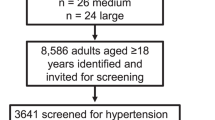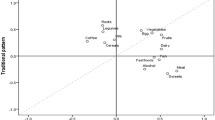Abstract
Although clinical hypertension occurs less frequently in children than in adults, ample evidence supports the concept that the roots of essential hypertension extend back to childhood. Since little is available in the literature on causal dietary factors of hypertension in children, this study hypothesised that certain dietary factors can be identified as risk markers that might contribute to the aetiology of hypertension in black children. Children aged 10–15 years were randomly selected from 30 schools in the North West Province from 2000 to 2001. These children comprised 321 black males and 373 females from rural to urbanised communities, of which 40 male and 79 female subjects were identified with high-normal to hypertensive blood pressure. Blood pressure was measured with a Finapres apparatus and data were analysed with the Fast Modelflo software program to provide systolic, diastolic and mean blood pressure. A 24-h dietary recall questionnaire and weight and height measurements were taken. In a stepwise regression analysis, the following variables were significantly associated (P⩽0.05) with blood pressure parameters of hypertensive males: biotin, folic acid, pantothenic acid, zinc and magnesium. Energy, biotin and vitamin A intakes were significantly associated with blood pressure parameters of hypertensive females. No significant dietary markers were indicated for any of the normotensive groups. Dietary intakes of all of these nutrients were well below the dietary reference intakes. In conclusion, the dietary results coupled with the cardiovascular parameters of this study identified folic acid and biotin as risk markers that could contribute to the aetiology of hypertension in black persons. The low intakes of these nutrients, among others, is a matter of serious concern, as is the increasing tendency towards urbanisation.
This is a preview of subscription content, access via your institution
Access options
Subscribe to this journal
Receive 12 digital issues and online access to articles
$119.00 per year
only $9.92 per issue
Buy this article
- Purchase on Springer Link
- Instant access to full article PDF
Prices may be subject to local taxes which are calculated during checkout
Similar content being viewed by others
References
World Health Organization–International Society of Hypertension. Guidelines for the Management of Hypertension. J Hum Hypertens 1999; 17: 151–183.
Seedat YK, Seedat MA, Hackland DBT . Prevalence of hypertension in urban and rural Zulu. J Epidemiol Commun Health 1982; 36: 256–261.
Isaacson C, Milne FJ, Van Niekerk I . Hypertension in black South Africans—new perspectives on old material. S Afr Med J 1989; 76: 323–324.
Seedat YK . Hypertension in developing nations in sub-Saharan Africa. J Hum Hypertens 2000; 14: 739–747.
Van Rooyen JM et al. An epidemiological study of hypertension and its determinants in a population in transition: the THUSA study. J Hum Hypertens 2000; 14: 779–787.
Joint National Committee The fifth report of the Joint National Committee on Detection, Evaluation, and Treatment of High Blood Pressure. Arch Intern Med 1993; 153: 154–183.
Sinaiko AR et al. Renin–angiotensin and sympathetic nervous system activity in grade school children. Hypertension 1982; 4: 299–306.
Sinaiko AR, Gomez-Marin O, Prineas RJ . Prevalence of ‘significant’ hypertension in junior high school-aged children: the Children and Adolescent Blood Pressure Program. J Pediatr 1989; 114: 664–669.
Lauer RM, Clarke WR . Childhood risk factors for high adult blood pressure: the Muscatine Study. Pediatrics 1984; 84: 633–641.
Simons-Morton DG et al. Nutrient intake and blood pressure in the Dietary Intervention Study in Children. Hypertension 1997; 29: 930–936.
Williams RR et al. Genetic traits related to hypertension and electrolyte metabolism. Hypertension 1991; 17: 1-69–I-73.
Hornstra G et al. Functional food science and the cardiovascular system. Br J Nutr 1998; 80 (Suppl) S113–S146.
Appel LJ et al. A clinical trial of the effects of dietary patterns on blood pressure. N Engl J Med 1997; 336: 1117–1124.
McCarron DA et al. Nutritional management of cardiovascular risk factors. A randomized clinical trial. Arch Intern Med 1997; 157: 169–177.
McCarron DA . Diet and blood pressure—the paradigm shift. Science 1998; 281: 933–934.
Simons-Morton DG, Obarzanek E . Diet and blood pressure in children and adolescents. Pediatr Nephrol 1997; 11: 244–249.
National High Blood Pressure Education Program Working Group on Hypertension Control in Children and Adolescents. Update on the 1987 Task Force Report on High Blood Pressure in Children and Adolescents: a working group report from the National High Blood Pressure Education Program. Pediatrics 1996; 98: 649–658.
Wesseling KH, Settels JJ, De Wit B . The measurement of continuous finger arterial pressure noninvasively in stationary subjects. In: Schmidt TH, Dembroski TM, Blümchen G (eds). Biological Factors in Cardiovascular Disease. Springer: Berlin, 1986, pp 355–375.
Silke B, McAuley D . Accuracy and precision of blood pressure determination with the Finapres: an overview using re-sampling statistics. J Hum Hypertens 1998; 12: 403–409.
Wesseling KH, Jansen JRC, Settels JJ, Schreuder JJ . Computation of aortic flow from pressure in humans using a nonlinear, three-element model. J Appl Physiol 1993; 75: 2566–2673.
McAuley D, Silke B, Farrel S . Reliability of blood pressure determination with the Finapres with altered physiological states or pharmacodynamic conditions. Clin Auton Res 1997; 7: 179–184.
Langewouters GJ, Settels JJ, Roelandt R, Wesseling KH . Why use Finapres or Portapres rather than intra-arterial or intermittent non-invasive techniques of blood pressure measurement?. J Med Eng Technol 1998; 22: 37–43.
Imholz BPM, Wieling W, Van Montfrans GA, Wesseling KH . Fifteen years experience with finger arterial pressure monitoring: assessment of the technology. Cardiovasc Res 1998; 38: 605–616.
Harms MPM et al. Continuous stroke volume monitoring by modelling flow from non-invasive measurement of arterial pressure in humans under orthostatic stress. Clin Sci 1999; 97: 291–301.
Norton K, Olds T . Anthropometrica: A Textbook of Body Measurement for Sports and Health Courses, UNSW Press: Sydney 1996.
Falkner B, Sherif K, Michel S, Kushner H . Dietary nutrients and blood pressure in urban minority adolescents at risk for hypertension. Arch Pediatr Adolesc Med 2000; 154: 918–922.
Hajjar IM, Grim CE, George V, Kotchen TA . Impact of diet on blood pressure and age-related changes in blood pressure in the US population. Arch Intern Med 2001; 161: 589–593.
Langenhoven M, Kruger M, Gouws E, Faber M . MRC Food Composition Tables, Medical Research Council: Tygerberg (1991.
StatSoft, Inc. STATISTICA for Windows (Computer program manual). StatSoft, Inc.: Tulsa, OK, 2000.
Food and Nutrition Board (FNB), National Research Council, NAS. Recommended Dietary Allowances, 10th edn. National Academy Press: Washington, DC 1989.
Schlacter J et al. Comparison of sodium and potassium intake with excretion. Hypertension 1980; 2: 695–699.
Vorster HH et al. The Nutritional Status of South Africans. A Review of the Literature from 1975–1996. Health Systems Trust: Durban, 1997, pp 1–47.
Institute of Medicine, Food and Nutrition Board Dietary Reference Intakes. Proposed Definition and Plan for Review of Dietary Antioxidants and Related Compounds, National Academy Press: Washington, DC 1998.
Whelton PK et al. Effects of oral potassium on blood pressure: meta-analysis of randomized controlled clinical trials. JAMA 1997; 277: 1624–1632.
Miller GD, DiRienzo DD, Reusser ME, McCarron DA . Benefits of dairy product consumption on blood pressure in humans: a summary of the biomedical literature. J Am Coll Nutr 2000; 19 (Suppl) 147S–164S.
National High Blood Pressure Education Program NHBPEP. Working Group report on primary prevention of hypertension. Arch Intern Med 1993; 153: 186
Chait A et al. Increased dietary micronutrients decrease serum homocysteine concentrations in patients at high risk of cardiovascular disease. Am J Clin Nutr 1999; 70: 881–887.
Prasad K . Homocysteine, a risk factor for cardiovascular disease. Int J Angiol 1999; 8: 76–86.
Mock DM . Biotin status: which are valid indicators and how do we know? J Nutr 1999; 129 ( Suppl): 298S–303S.
Said HM . Biotin availability and estimated average requirement: why bother? Am J Clin Nutr 1999; 69: 352–353.
Zempleni J, Mock DM . Biotin biochemistry and human requirements. J Nutr Biochem 1999; 10: 128–138.
Combs GF . Vitamins. In: Mahan LK, Escott-Stump S (eds). Krause's Food, Nutrition, and Diet Therapy. W.B. Saunders Company: Philadelphia, 2000, pp 67–109.
Ho RC, Cordain L . The potential role of biotin insufficiency on essential fatty acid metabolism and cardiovascular disease risk. Nutr Res 2000; 20: 1201–1212.
Acknowledgements
We are grateful to Prof. HS Steyn for his statistical consultation.
Author information
Authors and Affiliations
Corresponding author
Rights and permissions
About this article
Cite this article
Schutte, A., van Rooyen, J., Huisman, H. et al. Dietary risk markers that contribute to the aetiology of hypertension in black South African children: the THUSA BANA study. J Hum Hypertens 17, 29–35 (2003). https://doi.org/10.1038/sj.jhh.1001508
Received:
Revised:
Accepted:
Published:
Issue Date:
DOI: https://doi.org/10.1038/sj.jhh.1001508
Keywords
This article is cited by
-
Association between methyl donor nutrients and metabolic health status in overweight and obese adolescents
Scientific Reports (2022)
-
Associations Between Copper and Zinc and High Blood Pressure in Children and Adolescents Aged 8–17 Years: an Exposure-Response Analysis of NHANES 2007–2016
Biological Trace Element Research (2020)
-
Childhood adiposity trajectories are associated with late adolescent blood pressure: birth to twenty cohort
BMC Public Health (2016)
-
Blood pressure tracking in urban black South African children: birth to twenty cohort
BMC Pediatrics (2015)
-
Aqueous extract of dioscorea opposita thunb. normalizes the hypertension in 2K1C hypertensive rats
BMC Complementary and Alternative Medicine (2014)



